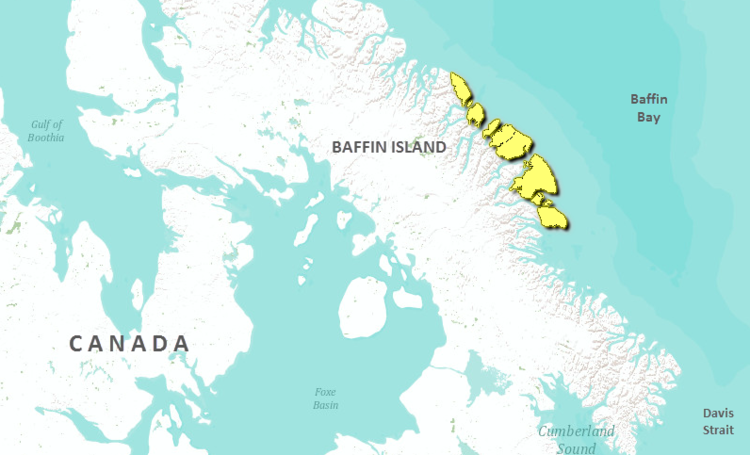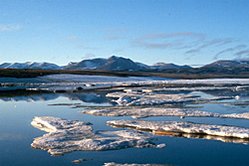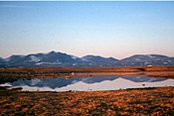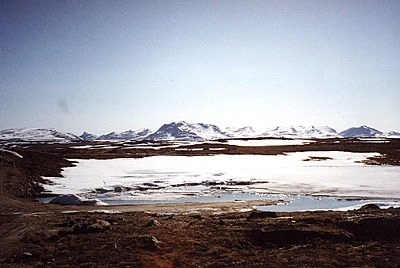Baffin coastal tundra
The ecoregion, characterized primarily as a coastal plain, is situated on the central north coast of Baffin Island and is relatively small in area.
This ecoregion is characterized by a high arctic ecoclimate. The humid, cold arctic climate is marked by short, cold summers (mean temperature 1°C), and long, cold winters (mean temperature -22.5°C). The mean annual temperature is around -11.5°C, and mean annual precipitation ranges between 200 millimeters (mm) and 300 mm.
 WWF The ecoregion is geologically composed of crystalline Precambrian massive rocks that occur as isolate outliers from peninsulas, and fjords that extend out from the Davis Highlands. It is a gently warped, old erosion surface with permafrost with low ice content.
WWF The ecoregion is geologically composed of crystalline Precambrian massive rocks that occur as isolate outliers from peninsulas, and fjords that extend out from the Davis Highlands. It is a gently warped, old erosion surface with permafrost with low ice content.
Biological Distinctiveness
 Near Clyde River, Baffin Island, Nunavut, Canada. (Source: Photograph by Biz Agnew/WWF)
Near Clyde River, Baffin Island, Nunavut, Canada. (Source: Photograph by Biz Agnew/WWF) The ecoregion has a sparse vegetative cover of mixed low-growing herbs and shrubs, consisting of moss, purple saxifrage (Saxifraga oppositifolia), Dryas, arctic willow (Salix arctica), Kobresia, sedge (Carex spp.) and arctic poppy (Papaver radicadum). Wet sites can develop up to about 60 percent cover of wood rush (Luzula spp.), wire rush (Juncus spp.) and saxifrage (Saxifraga spp.), along with a nearly continuous cover of mosses.
Characteristic wildlife include arctic hare (Lepus arcticus), arctic fox (Alopex lagopus), lemming (Lemminae), and caribou (Rangifer tarandus). Polar bears (Ursus maritimus) are common in the coastal areas; a large proportion of the Northwest Territory/Greenland shared population of polar bears use this coastal ecoregion in summer. Representative birds include king eider (Somateria spectabilis), rock ptarmigan (Lagopus mutus), northern fulmar (Fulmarus glacialis), plover (Charadrius spp. and Pluvialis spp.), hoary redpoll (Carduelis hornemanni), and snow bunting (Plectrophenax nivalis).
Conservation Status
Habitat Loss and Degradation
 Near Clyde River, Baffin Island, Nunavut, Canada. (Source: Photograph by Biz Agnew/WWF)
Near Clyde River, Baffin Island, Nunavut, Canada. (Source: Photograph by Biz Agnew/WWF) The ecoregion is still intact.
Remaining Blocks of Intact Habitat
Although naturally dissected by fjords, the ecoregion habitat is intact.
Degree of Fragmentation
The highly indented coastline means that the eastern Baffin coast is naturally fragmented. This land pattern could mean that the ecoregion might be vulnerable to anthropogenic fragmentation from any future human land use (Land-use and land-cover change).
Degree of Protection
There are no protected areas.
Types and Severity of Threats
There are relatively minor threats. Atmospheric fallout resulting in heavy metal and pesticide pollution are among the threats. There is a risk of oil spills in this coastal area.
Suite of Priority Activities to Enhance Biodiversity Conservation
- Establish a representative protected area.
- Develop a wildlife management plan.
Conservation Partners
- Canadian Arctic Resources Committee
- Ecology North
- Nunavut Wildlife Management Board
- World Wildlife Fund Canada
| Disclaimer: This article is taken wholly from, or contains information that was originally published by, the World Wildlife Fund. Topic editors and authors for the Encyclopedia of Earth may have edited its content or added new information. The use of information from the World Wildlife Fund should not be construed as support for or endorsement by that organization for any new information added by EoE personnel, or for any editing of the original content. |
